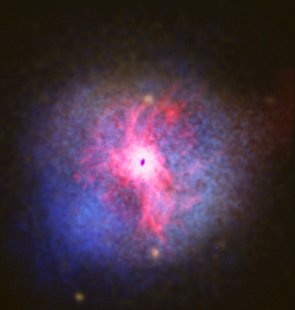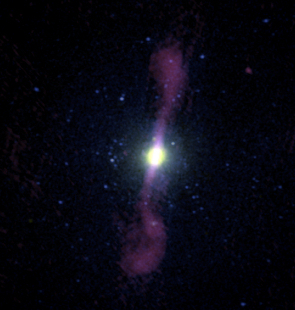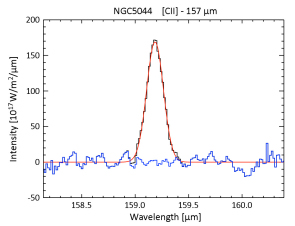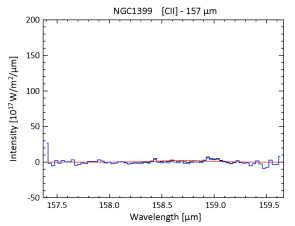Bullying black holes force galaxies to stay red and dead
25 February 2014
Herschel has discovered massive elliptical galaxies in the nearby Universe containing plenty of cold gas, even though the galaxies fail to produce new stars. Comparison with other data suggests that, while hot gas cools down in these galaxies, stars do not form because jets from the central supermassive black hole heat or stir up the gas and prevent it from turning into stars.
 |
| Multi-wavelength view of the elliptical galaxy NGC 5044. Credit: Digitised Sky Survey/NASA Chandra/Southern Observatory for Astrophysical Research/Very Large Array (Robert Dunn et al. 2010) |
Giant elliptical galaxies are the most puzzling type of galaxy in the Universe. Since they mysteriously shut down their star-forming activity and remain home only to the longest-lived of their stars – which are low-mass ones and appear red – astronomers often call these galaxies 'red and dead'.
Up until now, it was thought that red-and-dead galaxies were poor in cold gas – the vital raw material from which stars are born. While cold gas is abundant in spiral galaxies with lively star formation, the lack of it in giant ellipticals seemed to explain the absence of new stars.
Astronomers have long been debating the physical processes leading to the end of their star formation. They speculated that these galaxies somehow expelled the cold gas, or that they had simply used it all to form stars in the past. Although the reason was uncertain, one thing seemed to have been established: these galaxies are red and dead because they no longer possess the means to sustain the production of stars.
This view is being challenged by a new study based on data from ESA's Herschel Space Observatory. The results are published in Monthly Notices of the Royal Astronomical Society.
"We looked at eight giant elliptical galaxies that nobody had looked at with Herschel before and we were delighted to find that, contrary to previous belief, six out of eight abound with cold gas", explains Norbert Werner from Stanford University in California, USA, who led the study.
This is the first time that astronomers have seen large amounts of cold gas in red-and-dead galaxies that are not located at the centre of a massive galaxy cluster.
The cold gas manifested itself through far-infrared emissions from carbon ions and oxygen atoms. Herschel's sensitivity at these wavelengths was instrumental to the discovery.
"While we see cold gas, there is no sign of ongoing star formation," says co-author Raymond Oonk from ASTRON, the Netherlands Institute for Radio Astronomy.
"This is bizarre: with plenty of cold gas at their disposal, why aren't these galaxies forming stars?"
 |
| Multi-wavelength view of the elliptical galaxy NGC 1399 and its powerful jets. Credit: Digitised Sky Survey/NASA Chandra/Very Large Array (Robert Dunn et al. 2010) |
The astronomers proceeded to investigate their sample of galaxies across the electromagnetic spectrum, since gas at different temperatures shines brightly at different wavelengths. They used optical images to probe the warm gas – at slightly higher temperatures than the cold one detected with Herschel, and X-ray data from NASA's Chandra X-ray Observatory to trace the hot gas, up to tens of millions of K.
"In the six galaxies that are rich in cold gas, the X-ray data show tell-tale signs that the hot gas is cooling," says Werner.
This is consistent with theoretical expectations: once cooled, the hot gas would become the warm and cold gas that are observed at longer wavelengths. However, in these galaxies the cooling process somehow stopped, and the cold gas failed to condense and form stars.
In the other two galaxies of the sample – the ones without cold gas – the hot gas does not appear to be cooling at all.
"The contrasting behaviour of these galaxies may have a common explanation: the central supermassive black hole," adds Oonk.
In some theoretical models, the level of a black hole's activity could explain why gas in a galaxy is able – or not able – to cool and form stars. And this seems to apply for the galaxies studied by Werner and his colleagues, too.
While the six galaxies with plenty of cold gas harbour moderately active black holes at their centres, the other two show a marked difference. In the two galaxies without cold gas, the central black holes are accreting matter at frenzied pace, as confirmed by radio observations showing powerful jets of highly energetic particles that stem from their cores.
The jets could be an effect of the hot gas cooling down, and flowing towards the centre of the galaxies. This inflow of cold gas can boost the black hole's accretion rate, launching the jets that are observed at radio wavelengths.
The jets, in turn, have the potential to reheat the galaxy's reservoir of cold gas – or even to push it beyond the galaxy's reach. This scenario can explain the absence of star formation in all the galaxies observed in this study and, at the same time, the lack of cold gas in those with powerful jets.
"These galaxies are red, but with the giant black holes pumping in their hearts, they are definitely not dead," comments Werner.
"Once again, Herschel has detected something that was never seen before: significant amounts of cold gas in nearby red-and-dead galaxies," notes Göran Pilbratt, Herschel Project Scientist at ESA, "nevertheless, these galaxies do not form stars, and the culprit seems to be the black hole."
Background information
The study presented here is based on observations performed with the Photodetector Array Camera and Spectrometer (PACS) on board ESA's Herschel Space Observatory.
In addition, the astronomers also used optical observations from the Southern Observatory for Astrophysical Research (SOAR) telescope in Chile and archival X-ray data from NASA's Chandra X-ray Observatory.
Herschel is an ESA space observatory with science instruments provided by European-led Principal Investigator consortia and with important participation from NASA.
The PACS instrument contains an imaging photometer (camera) and an imaging spectrometer. The camera operates in three bands centred on 70, 100, and 160 μm, respectively, and the spectrometer covers the wavelength range between 51 and 220 μm. PACS has been developed by a consortium of institutes led by MPE (Germany) and including UVIE (Austria); KU Leuven, CSL, IMEC (Belgium); CEA, LAM (France); MPIA (Germany); INAF-IFSI/OAA/OAP/OAT, LENS, SISSA (Italy); IAC (Spain). This development has been supported by the funding agencies BMVIT (Austria), ESA-PRODEX (Belgium), CEA/CNES (France), DLR (Germany), ASI/INAF (Italy), and CICYT/MCYT (Spain).
Herschel was launched on 14 May 2009 and completed science observations on 29 April 2013.
Related publication
N. Werner, et al., "The origin of cold gas in giant elliptical galaxies and its role in fuelling radio-mode AGN feedback", 2014, Monthly Notices of the Royal Astronomical Society, doi: 10.1093/mnras/stu006.
Contacts
Norbert Werner
Kavli Institute for Particle Astrophysics and Cosmology
and Department of Physics, Stanford University
Stanford, CA, USA
Email: norbertw![]() stanford.edu
stanford.edu
Phone: +81-90-6489-3142
J. B. Raymond Oonk
ASTRON, Netherlands Institute for Radio Astronomy
Dwingeloo, The Netherlands
Email: oonk![]() astron.nl
astron.nl
Phone: +31-521-595-766
Göran Pilbratt
Herschel Project Scientist
Scientific Support Office
Science and Robotic Exploration Directorate
ESA, The Netherlands
Email: gpilbratt![]() rssd.esa.int
rssd.esa.int
Phone: +31-71-565-3621






